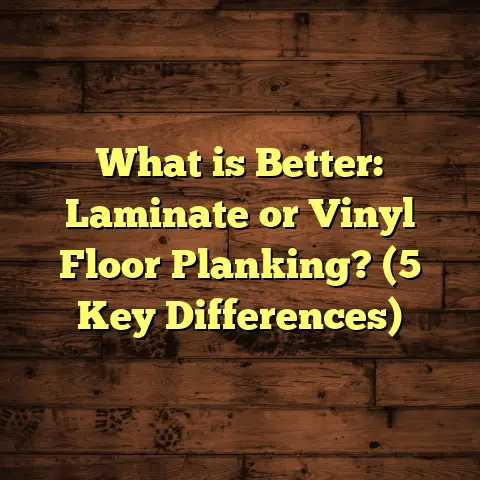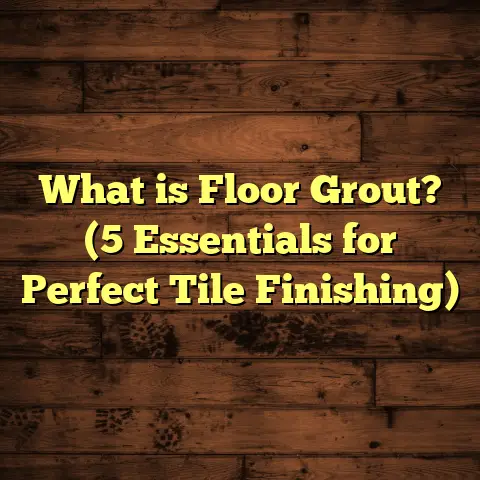What is a Floor Sander? (5 Benefits for Flawless Flooring)
A floor sander is the secret weapon for anyone wanting flawless hardwood floors without spending a fortune on replacements. I learned this the hard way after staring down years of abuse on my own floors — those ugly scratches and stubborn stains that seemed impossible to fix. If you’ve ever felt stuck wondering how to bring your wooden floors back to life, I’m here to share everything I know about floor sanders, their benefits, costs, and how they can transform your space.
What Is a Floor Sander?
Let me start by breaking it down simply: a floor sander is a power tool made specifically for sanding wood flooring. Unlike handheld sanders meant for furniture or small projects, floor sanders are designed to cover large surface areas efficiently while smoothing out imperfections.
There are several types of floor sanders I’ve used over the years, each suited to different tasks:
Drum Sanders
This is the classic heavy-duty machine you often see in professional refinishing jobs. It consists of a large cylindrical drum wrapped in sandpaper that spins at high speed. When you push the sander along the floor, it aggressively sands away the surface layers — old paint, varnish, scratches, and dents.
Drum sanders weigh between 60 and 100 pounds and typically operate at around 1,800 revolutions per minute (RPM). Because they remove so much material quickly, they require a steady hand. I remember my first time using one; I had to keep it moving constantly to avoid creating gouges.
These machines are usually rented from hardware stores or equipment rental shops. Rental fees range from $60 to $110 per day depending on your location — in big cities like Los Angeles or New York, expect prices on the higher end. Planning a weekend project? You might also find weekly rates around $200–$300.
Orbital Sanders (Random Orbital Sanders)
Orbital sanders are lighter and less aggressive than drum sanders. They move in a random pattern that prevents swirl marks — those annoying circular scratches you sometimes see after sanding.
I use orbital sanders mostly for finishing after the drum sander has done its job or for smaller patches. They’re great for DIYers who want smooth results without risking deep scratches.
These machines weigh about 4 to 8 pounds and cost roughly $100–$300 to buy. Rentals are cheaper, usually under $50 per day.
Edgers
Edges and corners are a pain point for sanding because big machines can’t reach close enough. That’s where edgers come in — smaller sanders with a rotating disc designed for tight spots.
I always recommend renting or buying an edger if you’re sanding an entire room yourself. It ensures every inch of your floor is evenly finished.
Belt Sanders and Other Specialty Sanders
Sometimes, belt sanders or specialized hand-held tools are used for spot repairs or specific finishes. But for whole-room hardwood floors, drum sanders, orbital sanders, and edgers form the core toolkit.
Why Should You Care About Floor Sanders? 5 Benefits You’ll Love
After sanding countless floors myself and helping friends with theirs, I can confidently say that using a floor sander isn’t just about surface beauty — it’s about bringing your home back to life in ways subtle but powerful.
1. Brings Old Floors Back to Life Like Magic
How many times have you looked down at scratched hardwood floors and thought, “They’re ruined”? I did that for years before deciding to try sanding.
Sanding removes the top damaged layers of wood — scratches, stains from pets, water damage, and old finishes that have yellowed or peeled. It’s like giving your floor a fresh start without needing new planks.
In one case, I helped a client with floors over 50 years old. The wood was darkened by decades of dirt and wear. After sanding down just 1/16 of an inch (about 1.5 mm) of the surface—just enough to remove all damage—the floor looked vibrant and warm again. That’s such a small amount of wood but makes a huge aesthetic difference.
2. Creates an Even Surface That Feels Great Underfoot
If your floor has bumps, waves, or uneven patches, it’s not just ugly — it can be uncomfortable or unsafe.
Using a drum sander levels out these imperfections by removing high spots gradually. Combined with proper subfloor preparation before installation, sanding helps create flat floors that feel solid when you walk on them.
I recall working on a rental property where the previous owner installed wood planks over an uneven concrete slab. The floors were noticeably wavy. After sanding multiple passes and some minor leveling compounds underneath, we got the floors near-perfectly flat — so much so that guests complimented how “professional” it felt.
3. Prepares Floors Perfectly for New Finishes
Have you ever tried staining or sealing a rough or dirty wood surface? The finish often looks blotchy or peels off early.
Sanding opens up the wood grain so finishes like polyurethane or oil-based stains adhere evenly and last longer. This is because sanding removes old residues and creates a slightly roughened texture where finish coats bond better.
When I refinish floors professionally, I always stress this step. Skipping sanding leads to wasted time and money because you’ll have to redo finishes sooner.
4. Costs Significantly Less Than Replacing Floors
Replacing hardwood floors is expensive — depending on species and quality, new floors run from $8 to $15 per square foot installed.
Sanding and refinishing generally cost between $1.50 and $4 per square foot if done professionally, or less if DIY with rented equipment. For a typical 500-square-foot living room, that’s $4,000+ versus about $1,000–$2,000 for sanding and refinishing.
I saved thousands by sanding my own floors instead of replacing them. Plus, I kept the character of the original wood — which new floors often lack.
5. Boosts Home Value and Appeal
If you’re thinking about resale value, refinished hardwood floors are one of the best investments.
According to the National Association of Realtors (NAR), homes with well-maintained hardwood floors sell faster and can fetch up to 2% more in value compared to those with worn or damaged floors.
I’ve seen this firsthand with clients who refinished their floors before listing their homes — multiple offers came in within days after staging the space with fresh flooring.
Getting Started: How I Prepped My Floors for Sanding
Before you grab a sander and start buzzing around your room, there’s some prep work that makes all the difference.
Clearing the Room and Removing Baseboards
I always empty the room completely — furniture, rugs, even those pesky nails sticking out from previous installations. Anything left behind can interfere with sanding or get damaged.
For my last project, I removed baseboards carefully using a pry bar so I could sand right up to the edges without damaging trim.
Checking Nails and Gaps
Nails sticking up can ruin sandpaper quickly; I go around hammering any loose nails back down flush with the wood surface or removing them altogether.
Gaps between boards sometimes need filling before finishing; otherwise stains get trapped unevenly later on.
Cleaning Thoroughly
Dust and debris can clog sandpaper fast. Vacuuming and wiping down floors before starting help prolong paper life and keep dust under control during sanding.
The Sanding Process: Step-by-Step Insights From My Experience
If you’re curious about how sanding actually works in practice, here’s what I’ve learned from doing it multiple times:
Step 1: Coarse Sanding (36-40 Grit)
Begin with coarse-grit sandpaper on your drum sander. This removes old finishes and levels out major scratches or dents.
Keep the sander moving constantly — don’t stay still too long or you risk gouging the wood. Overlapping passes ensure even coverage.
Step 2: Medium Sanding (60-80 Grit)
Switch to medium grit to smooth rough spots left by coarse sanding.
This stage softens edges of scratches and prepares wood for finer finishing steps.
Step 3: Fine Sanding (100-120 Grit)
Use an orbital sander with fine grit paper for smooth final surfaces ready for staining or sealing.
This step removes swirl marks and gives wood a silky feel underfoot.
Step 4: Edge Sanding
Use an edger around walls and corners to ensure no spot is missed.
Edges often show wear first because they’re harder to reach during regular maintenance.
Step 5: Clean-Up
Vacuum dust thoroughly several times during and after sanding to avoid settling particles contaminating finishes.
I often wipe down floors with tack cloths for dust removal right before applying any stain or sealant.
Dust Control: Managing One of Sanding’s Biggest Challenges
If you’ve never sanded wood floors before, here’s a heads-up: it produces an incredible amount of dust.
In one project covering 300 square feet, I gathered nearly two pounds of fine dust in just an hour of sanding!
That’s why investing in good dust collection systems or vacuums attached to sanders is worth it. It keeps your workspace cleaner and safer for your lungs.
Wearing N95 masks during sanding is also something I highly recommend based on personal experience.
How Much Does Floor Sanding Cost?
You might be wondering — what’s the real price tag on this whole operation?
Costs vary widely based on:
- Room size
- Condition of floors
- Type of wood
- Whether you hire pros or DIY
- Location (urban vs rural)
For professional services in cities like Chicago or Dallas:
| Room Size (sq ft) | Cost Range (USD) |
|---|---|
| 200 | $400 – $800 |
| 400 | $800 – $1,600 |
| 600 | $1,200 – $2,400 |
DIY costs involve rental fees ($60–$110/day), sandpaper ($30–$100 per project), stains/sealants ($50–$200), plus your time.
Remember to factor in waste too — around 10% extra sandpaper is typical due to wear and tear during sanding.
How Tools Like FloorTally Help Me Stay Organized With Flooring Projects
One thing that helped me avoid budget headaches was using FloorTally — an online tool that calculates flooring costs based on local rates for materials and labor.
By entering room dimensions and choices like hardwood species or finish types, FloorTally estimates total costs including installation and sanding labor adjusted for my location in Seattle.
It even factors in waste materials so I’m not caught short buying extra supplies last minute. This saved me hours hunting down price lists manually.
If you want precise numbers without surprises, I recommend trying something similar during your planning phase.
Case Study: Refinishing a 500 sq ft Living Room Floor
Here’s a detailed example from one of my recent projects:
- Location: Portland, Oregon
- Floor Type: Red oak hardwood installed 25 years ago
- Condition: Numerous scratches from pets + some water stains near window
- Process:
- Removed baseboards
- Hammered down nails
- Vacuumed thoroughly
- Coarse drum sanding (36 grit) took about 3 hours
- Medium sanding (60 grit) took 2 hours
- Fine orbital sanding (100 grit) took 1 hour
- Edging took another hour
- Materials Used:
- Sandpaper rolls (36/60/100 grit)
- Water-based polyurethane finish (3 coats)
- Costs:
- Equipment rental: $220 (3 days)
- Materials: $150
- Labor (self-done): Free
- Outcome: Floor looked brand-new; client reported increased satisfaction living space felt warmer and more inviting
Pro Tips for First-Time Sanding Projects
- Rent equipment for at least two days even if you think one day will do — unexpected issues always pop up.
- Practice controlling sander speed and pressure on scrap wood before tackling your floor.
- Don’t rush grit progression; skipping steps leads to poor finish quality.
- Use high-quality sandpaper designed specifically for floor sanders.
- Always wear protective gear — masks, ear protection, goggles.
- Have patience! The process isn’t quick but results are worth it.
Common Mistakes To Avoid When Using Floor Sanders
When I started sanding floors myself, I made several mistakes that slowed me down:
- Staying too long in one spot causing gouges
- Failing to remove nails leading to torn sandpaper
- Using wrong grit sequence that left scratches
- Not cleaning dust regularly leading to clogged paper
- Ignoring edges where damage accumulates first
Learning from these helped me improve every project after that.
What Happens After Sanding? Finishing Options You Should Know About
Once your floor is perfectly sanded, it’s time to protect it with finishes. Here’s what I usually recommend:
- Polyurethane: Durable and available in water-based or oil-based varieties; water-based dries faster but oil-based gives warmer tone.
- Penetrating Oil Sealer: Enhances natural grain and feel but requires more frequent maintenance.
- Wax Finishes: Less common now but provide beautiful shine; not great for high traffic areas.
- Stains: Can be applied before sealers to change wood color; test small areas first to avoid surprises.
Each option has pros and cons depending on foot traffic levels and aesthetics desired.
How Often Should You Sand Hardwood Floors?
This depends on use but generally:
- Every 7–10 years for homes with moderate traffic
- Every 5 years in busy commercial spaces
Sanding removes old finish layers so doing it too often can thin wood excessively over decades.
Conclusion? Nah—More Like Next Steps!
Now that you know what a floor sander is all about — its types, benefits, costs, challenges, and best practices — what will you do next?
Are you thinking about giving your floors a fresh start? Or maybe hiring someone but feeling more confident asking the right questions?
Whatever route you take, remember that great wooden floors don’t happen by accident. They need care, knowledge, and sometimes that powerful little machine called a floor sander.
Feel free to ask me anything else about flooring—I love talking about this stuff!





